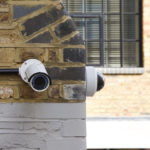Troubleshooting Infrared Security Cameras
If you’re looking for surveillance around-the-clock, infrared night vision cameras are a smart choice. These security cameras enable you to monitor your business or property overnight, when light sources are minimal. Night vision cameras have infrared (IR) LEDs which emit their own source of light, but of course, nothing is perfect. When using infrared cameras, you may come across some of these common IR issues.
Foam Ring
Keep in mind that not every camera will have one, but most of them do. The foam ring helps to eliminate the reflection of the IR light on the glass. When the IR light reflects off the glass and back into the lens, it will wash out your footage, essentially rendering your camera useless. If your camera seems to be missing a foam ring, first make sure that your camera should in fact have one. If so, to eliminate the issue, replace the foam ring.
While the aforementioned situation is rather unlikely, having an improperly placed foam ring is far more common. If the foam ring is not flush with the IR board, or the base of the lens, it will produce a similar effect as a missing foam ring. To correct this, you will need to open your camera and reposition the foam ring accordingly.
Glass
Most security cameras come with a thin plastic protective film over the glass on the camera. It is in place to protect the camera, however, it should not be left on when the camera is in use. Once your camera is installed and you are satisfied with the placement and viewing angle, remember to remove and discard the film covering.
Another common issue with the glass is obstructions. Dirt, dust, and fingerprints on the glass can create infrared glare which interferes with the quality of your footage. Be sure to clean the glass routinely to ensure that your cameras are obstruction-free.
Infrared Glare
As mentioned, debris on the camera or glass reflection can cause IR glare, but there are other common causes. With outdoor cameras, you want to avoid aiming your camera at reflective services (ex. bodies of water, large lightly colored surfaces). For indoor cameras, be wary of the items or furniture around your camera as they may be close enough to reflect the IR LEDs. Despite all this, the most common cause of IR glare is improper installation. Cameras should be carefully mounted and tested in both day and low light conditions before the job is completed.
Infrared Reflection
Here are some of the common things that cause IR reflection:
- Your camera is indoors looking through a window. Because the IR will bounce off the window, IR cameras should not be mounted behind any glass.
- For cameras with a glass dome cover, be sure that all the IR LEDs are looking through the glass dome. If your camera is set improperly inside the glass cover, the IR light will bounce inside the camera and hit the image sensor.
- Remember to remove the plastic cover on the outside of the glass dome
Clean the glass dome with a damp microfiber cloth or windshield cleaner only. - If your camera is mounted too close to a wall, ceiling, or between two walls, the IR LEDs will be obstructed and will result in IR reflection.
Infrared Obstruction
As mentioned, when an object is too close to your IR camera, IR light will cause overexposure. In turn, to compensate, your camera will automatically dim the picture, reducing the IR intensity of your camera. Again, proper placement, installation, and testing will minimize these issues.
Share your own troubleshooting tips with us and your peers on Facebook, Twitter, LinkedIn, and Pinterest.
Find a great selection of cost-effective infrared night vision cameras, CCTV surveillance packages and much more at SecurityCamExpert.com. Call 888-203-6294 to learn more about our products and services or to request a free quote!
